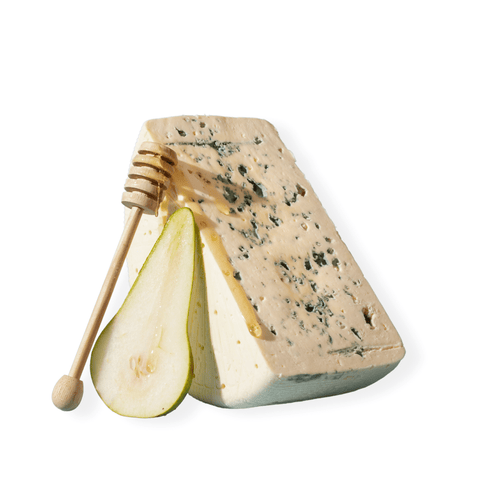





STRATHDON BLUE
Expiry date: 2025/10/31
Butter cream icing on the nose; voluptuous maturity on the palate
Styled around Bleu d’Auvergne from south, central France. A fairly high moisture blue made with quite high fat milk which helps advance a creamy texture. All blue tends to be high in salt at around 2.2% but when mature it’s almost impossible to tell as the flavour develops into a salty/sweet combination with a distinctive steely blue note to finish. Try a peated dram, they tend to be a touch sweeter and that always matches nicely with the salty note of a blue cheese, also a muscat or pudding wine.
145g
More complex than most Blues with bold cracks and streaks, this creamy, juicy cheese yields to the touch and fills the mouth with a delightfully fudgy texture, finishing on balanced notes of salt and steel. You need nothing more than a simple cracker or chunk of crusty loaf.
- Blue
- Washed Rind
- Creamy
Milk
Typical values per 100g Energy 1309kJ / 316kcal, Fat 26g,of which saturates 16g, Carbohydrate 2.9g, of which sugars Trace, Protein 18g, Salt 2g

STRATHDON BLUE
THE MAKING OF STRATHDON BLUE
Every cheese is crafted in Tain, ScotlandWe collect milk from local farms around Tain. Once the milk is received in our dairy, the milk goes through the pasteurisation process and will then be placed in vats. Cultures are added to begin the process of acidification. After a time, depending on how much acidity is required, rennet is stirred in, and the milk coagulates.
Cutting and Draining the CurdOnce a firm set has been achieved and depending upon how much moisture we wish to retain in any specific cheese style we will cut the curds. As a basic rule the smaller you cut the curd the more moisture you will release, so the curd aim to make cheddar is about the size of a frozen pea at cut whereas a brie’s would be nearer a big sugar lump. The curd is then stirred to help form a skin on each curd particle and to allow the process of syneresis to reduce the gel.
Bigger pieces of curd will retain more moisture and will be perfect for our STRATHDON BLUE
Shaping the cheese – MouldingOnce cut, stirred and drained the curd will be placed into moulds and will continue to acidify and drain but by removing most of the whey you steal the moisture, some warmth and a lot of lactose on which the cultures like to eat and develop, in this way you can stall the process so that you end up with the right moisture, size and texture depending upon cheese style.
Salting and MaturationYou can add salt to cheese in three ways. Salt needs to be added both to flavour and preserve the curd. In cheddar, we add the salt directly to the curd before placing it into moulds to be pressed into a barrel of cheddar. With STRATHDON BLUE we add salt by rubbing it onto the surface of the cheese.
After around 5 days the cheese is pierced to allow the penicillium Roqueforte to spore and grow inside the cheese, this can take 14 days, then it’s wrapped in aluminium foil and held at around 3 centigrade for 2 months.





